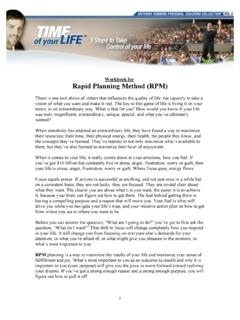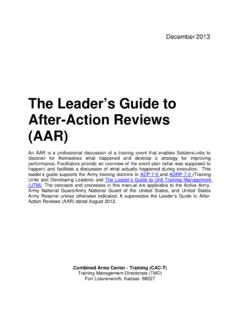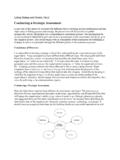Transcription of Interim Guide for creating public entities at the …
1 Interim Guide FOR creating public entities AT THE NATIONAL SPHERE OF GOVERNMENT Department of public Service and Administration National Treasury March 2002 TABLE OF CONTENTS Topic Paragraph Introduction 1 Rationale for agencification 2 Mandates 3 Process to create PEs 4 Deploying public servants to PEs 5 Conclusion 6 Annexures Annexure A: Cabinet approved broad process for creating PEs at the national sphere of government Annexure B: Process to create PEs at the national sphere of government Annexure C Broad categories of risks and their definitions Annexure D: Guidelines for the drafting of a PE enabling Bill DRAFT Interim Guide FOR creating public entities (PEs) AT THE NATIONAL SPHERE OF GOVERNMENT 1.
2 INTRODUCTION Cabinet approved on 4 April 2001, as an Interim measure, the broad process for the creation of national PEs as set out in Annexure A. This broad process is to remain in operation until it is replaced and/or updated by an appropriate institutional framework for PEs. Cabinet also approved that guidelines be developed which elucidate the broad process to create national PEs as well as on staff transfers between the public Service and PEs. This Guide therefore is the outcome of the above decision. The Guide is intended to be a living document, which will be updated with policy developments, agreements ( , with organised labour regarding staff and restructuring matters) and frameworks that impacts on PEs as well as the best practice experiences of Departments.
3 The Guide will remain in operation until it is replaced and/or updated by an appropriate institutional framework for PEs currently being developed through the PE project. This Guide focuses on: (a) The rationale for agencification. (b) Mandates for the creation, listing and classification of PEs. (c) Elucidating the process to create PEs. (d) Deploying (transferring) public servants to PEs which include - the process to deploy staff (transfer) from the public Service to PEs; and withdrawals from the Government Employees Pension Fund. 2. RATIONALE FOR AGENCIFICATION To improve the quality and cost of services available to citizens, Government is committed to "do more with less".
4 One mechanism has been to create semi-autonomous entities at arm's length from parent ministries. PEs are established in the public Sector, but outside the public Service, typically for reasons of - (a) strategic, social or economic intervention by the State or to deal with strategic risks and dangers that the State or society faces to its security, health, prosperity or wellbeing; and/or (b) adopting commercial and business principles in service delivery when it is required; and/or (c) signalling that there is need for objectivity and more operational autonomy, yet retaining accountability in the delivery of services.
5 The formal definition of a national PE as set out in Section 1 of the public Finance Management Act, 1999 (PFMA) is as follows: 2(a) A board, commission, company, corporation, fund or other entity (other than a national business enterprise) which is- (i) established in terms of national legislation; (ii) fully or substantially funded from either the National Revenue Fund or by way of tax, levy or other money imposed in terms of national legislation; and (iii) accountable to Parliament. (b) A national government business enterprise means an entity which- (i) is a juristic person under the ownership control of the national executive; (ii) has been assigned financial and operational authority to carry on a business activity; (iii) as its principal business, provides goods or services in accordance with ordinary business principles; and (iv) is financed fully or substantially from sources other than- the National Revenue Fund; or by way of a tax, levy or other statutory money.
6 ( ownership control , in relation to an entity, means the ability to exercise any of the following powers to govern the financial and operating policies of the entity in order to obtain benefits from its activities: (a) To appoint or remove all, or the majority of, the members of that entity s board of directors or equivalent governing body; (b) to appoint or remove that entity s chief executive officer; (c) to cast all, or the majority of, the votes at meetings of that board of directors or equivalent governing body; or (d) to control all, or the majority of, the voting rights at a general meeting of that entity.)
7 PEs in accordance with their formats have different levels of autonomy. Government Business Enterprises, which generate their own income, have the most autonomy as these entities operate in a competitive market place and decisions are made in accordance with business principles. These entities normally pay tax and could in future be required to pay dividends. PEs, other than the Government Business Enterprises, are normally extensions of a department with the mandate to fulfil a specific economic or social responsibility of Government. These entities are more reliant on Government funding and public money, either by means of a transfer from the Revenue Fund or through statutory money.
8 As such, these entities have the least autonomy and are also accountable to Government for this money. In addition, the relevant Minister (hereafter called the Executive Authority ) has the responsibility to approve these entities annual budget. 3. MANDATES FOR THE CREATION, LISTING AND CLASSIFICATION OF NATIONAL PEs Minister for the public Service and Administration (MPSA) The competency of the MPSA is aimed at the proper macro organisation of the public Service by ensuring that any new or existing public function is allocated/transferred to the appropriate sphere of government, department and/or PE and to eliminate any duplication of functions.
9 This competency involves: 3 (a) Advising the President regarding the establishment or abolition of any department or organisational component in the national sphere of government (Section 3(3)(a) of the public Service Act, 1994 (PSA)). (b) Making a determination regarding the allocation of any function to, or the abolition of, any department or the transfer of any function from one department to another or from a department to any other body or from any other body to a department (Section 3(3)(b) of the PSA) In cases where a PE is established for a new or existing function, the MPSA must make a determination regarding the allocation/transfer of such a function to a PE.
10 The allocation/transfer of functions and concomitant resources should be effected as far as possible with effect from the start of a financial year. Minister of Finance (MoF) The competency of the MoF is aimed at the establishment of uniform reporting and listing of all PEs, nationally and in the provinces, by ensuring that any new or existing PE is listed and accountable to Government. This competency involves making a determination regarding the allocation of monies from Government, including statutory funding, to a public entity or future public entity and ensuring that such an entity s funding requirements and mandate are within the ambit of the MTEF.
















